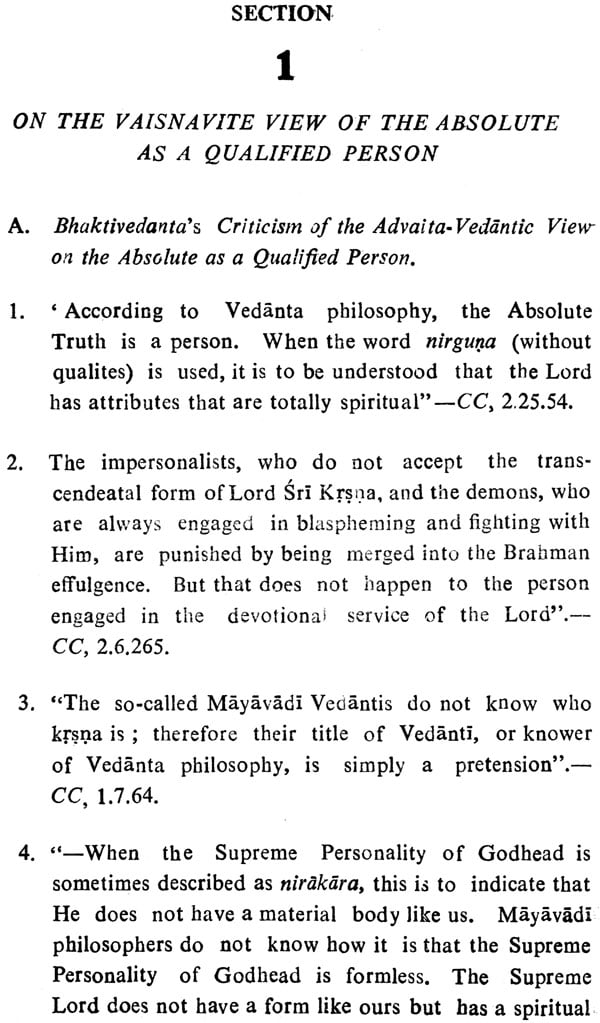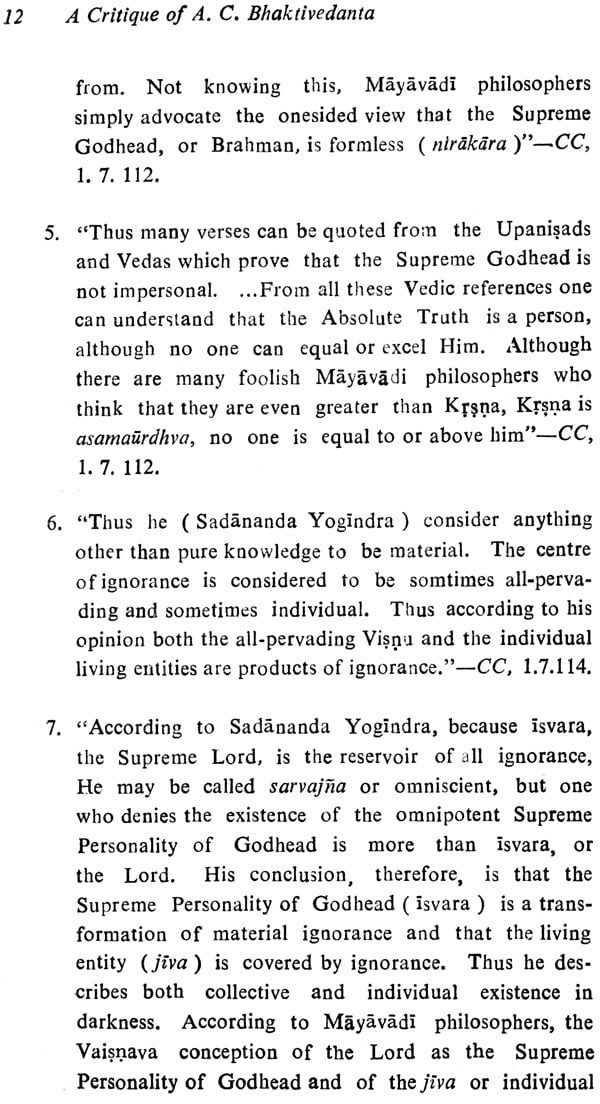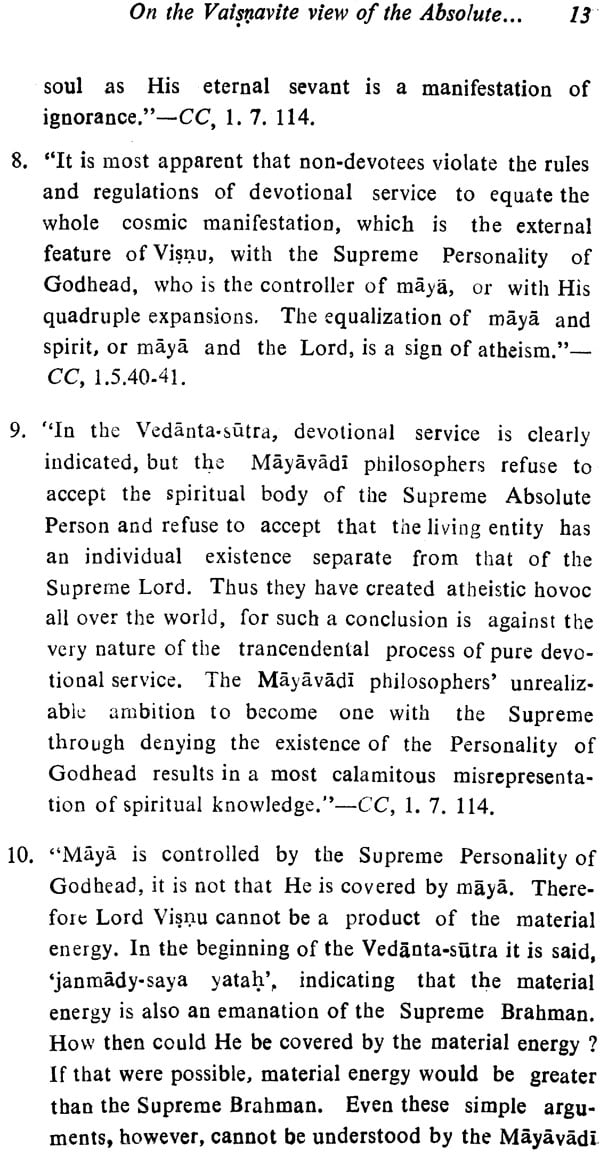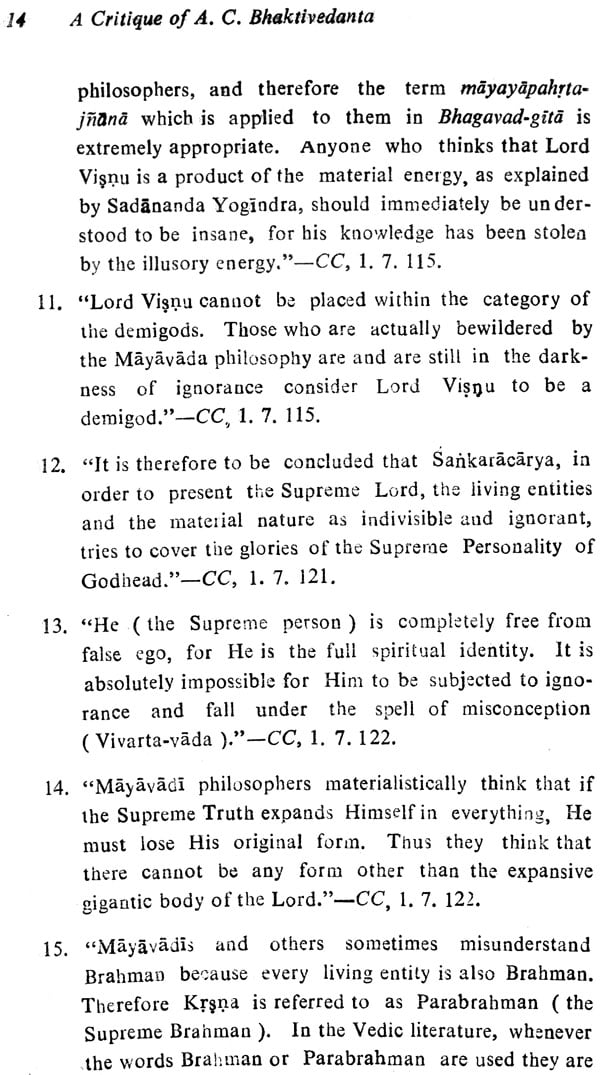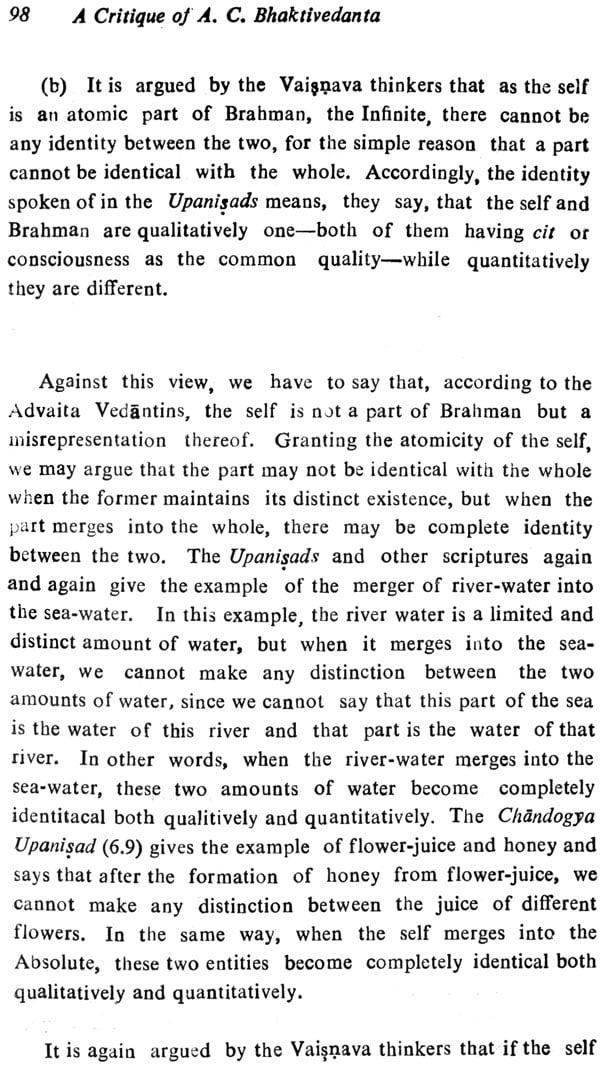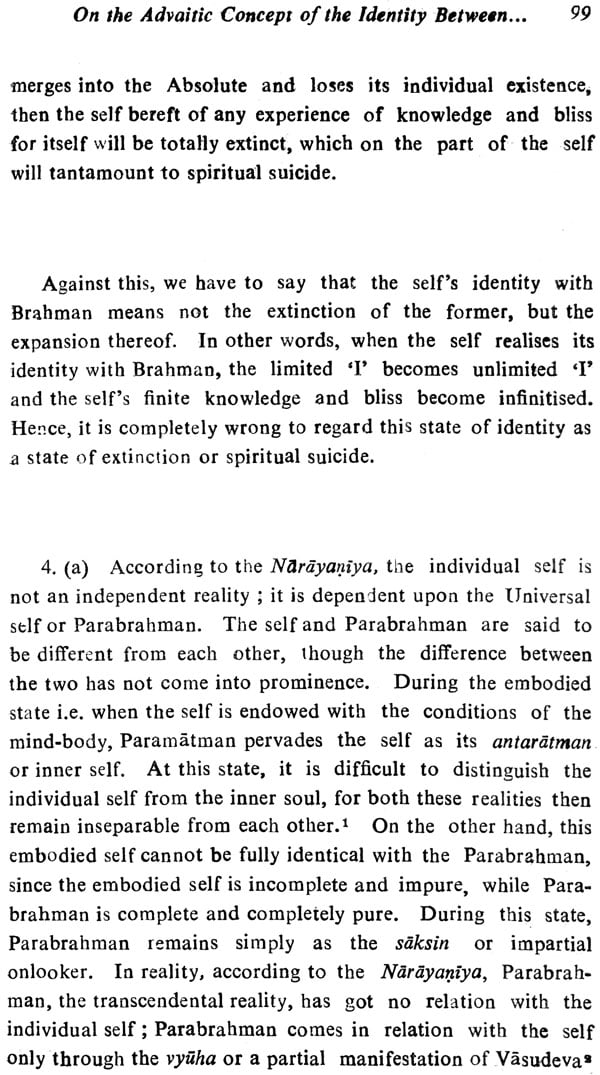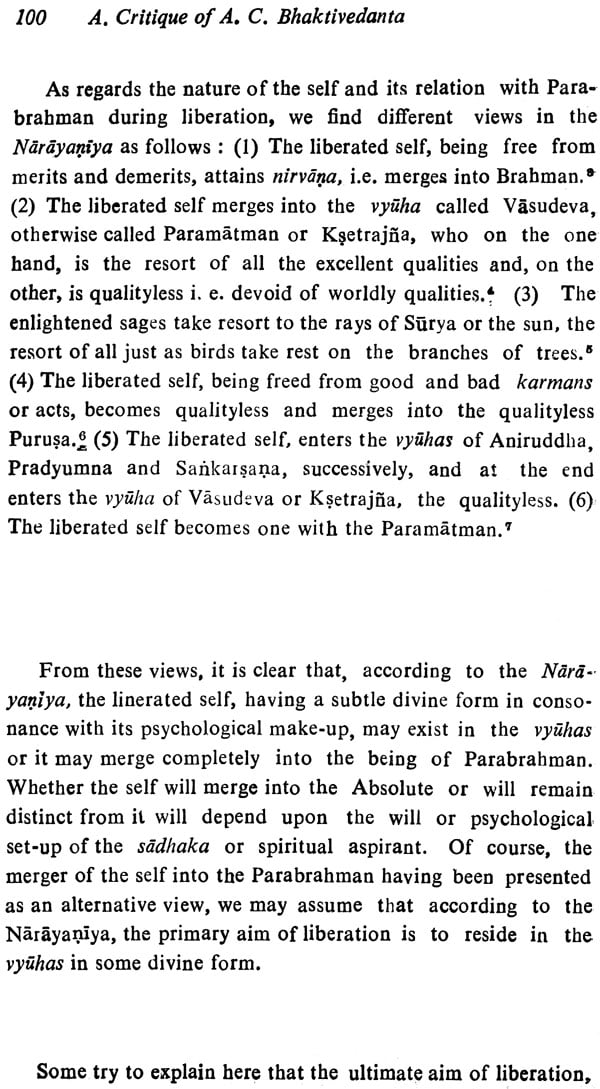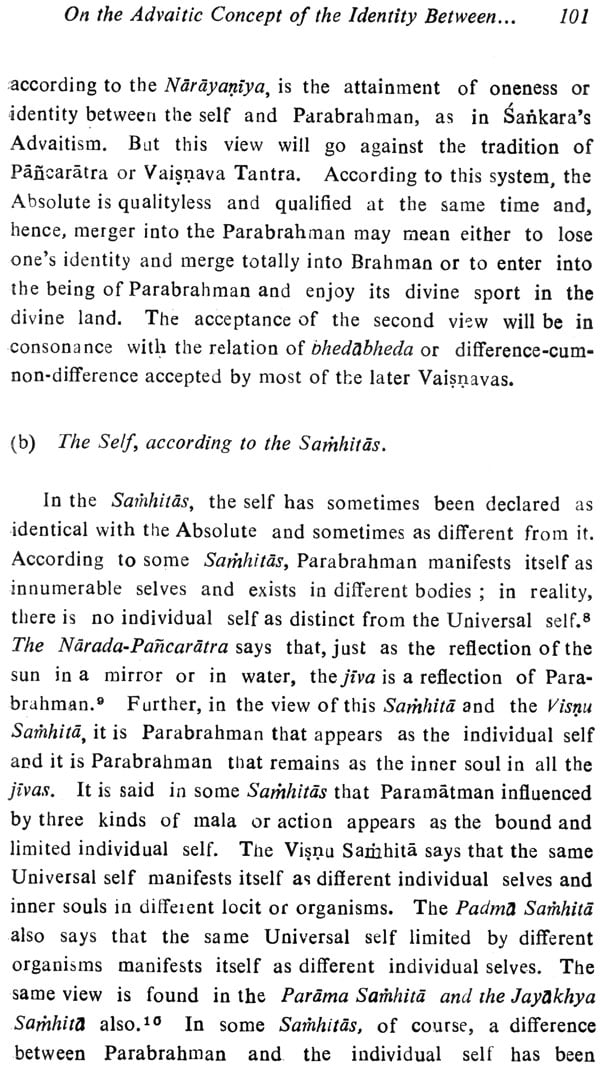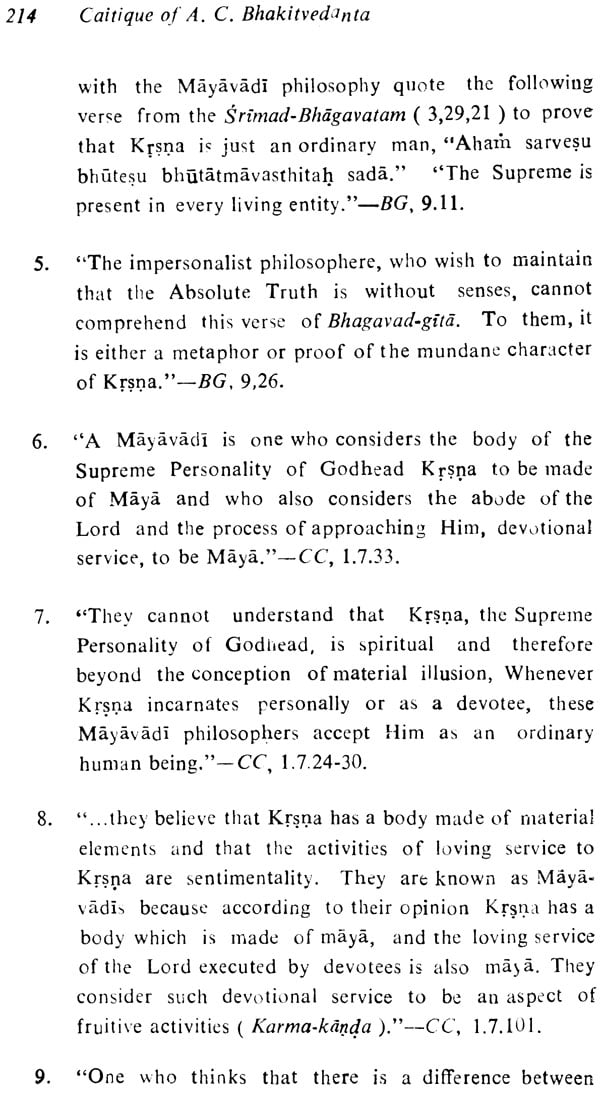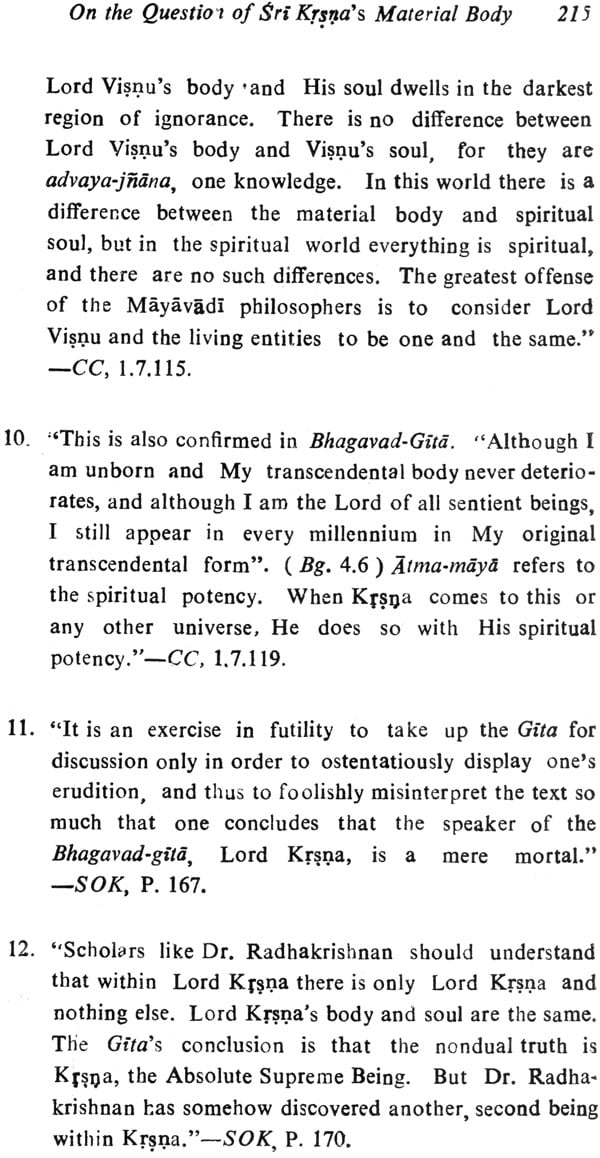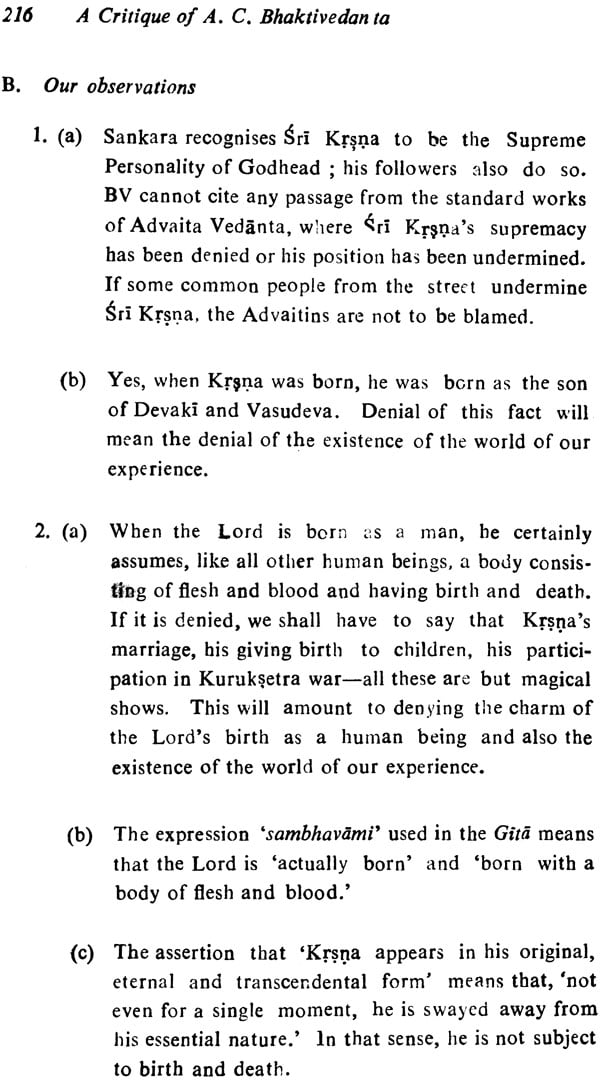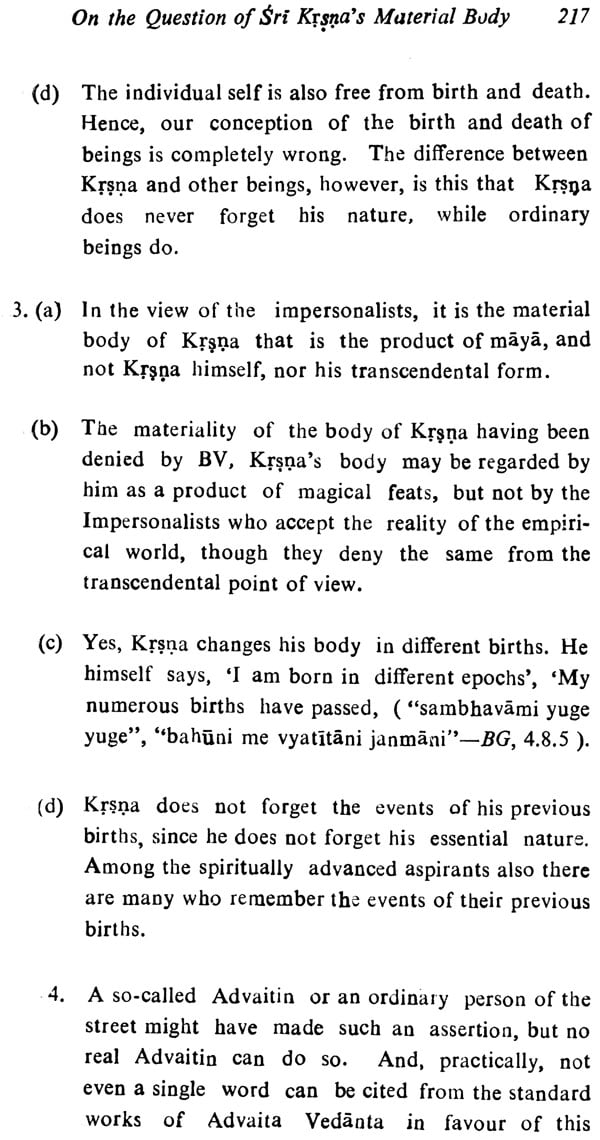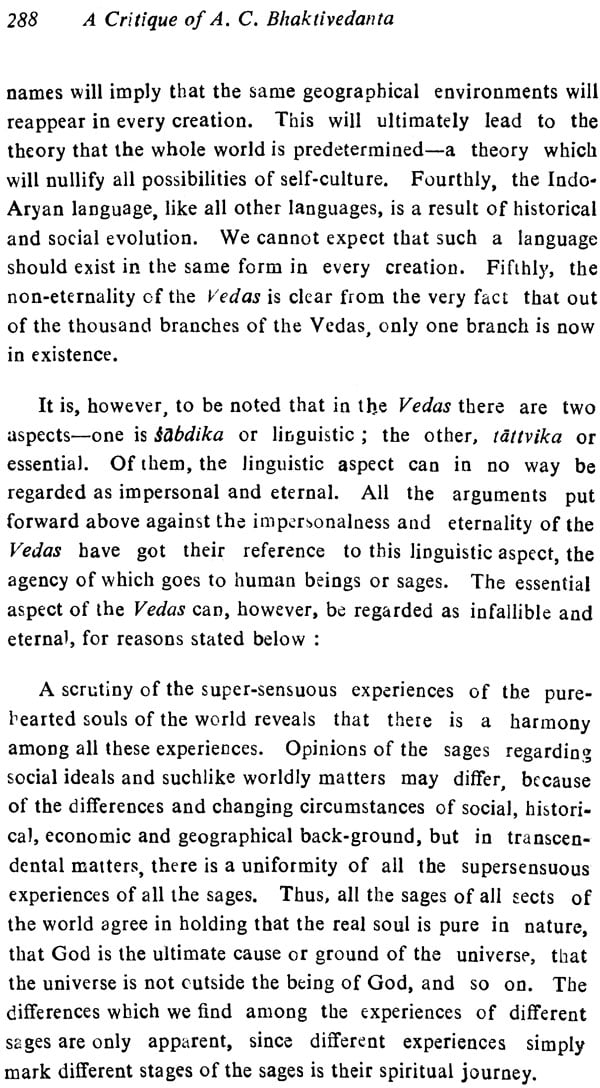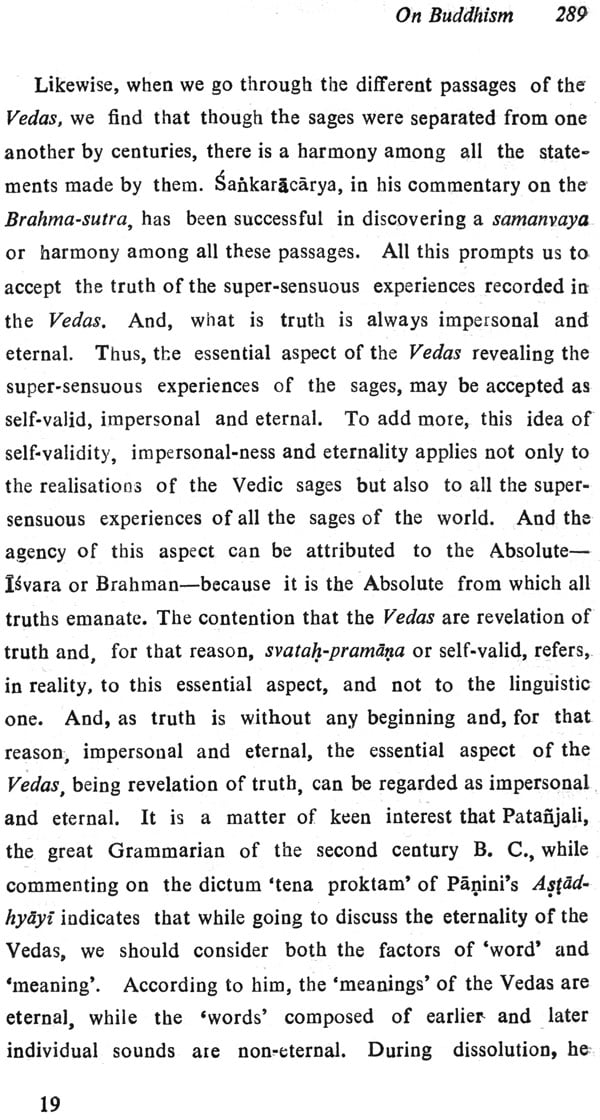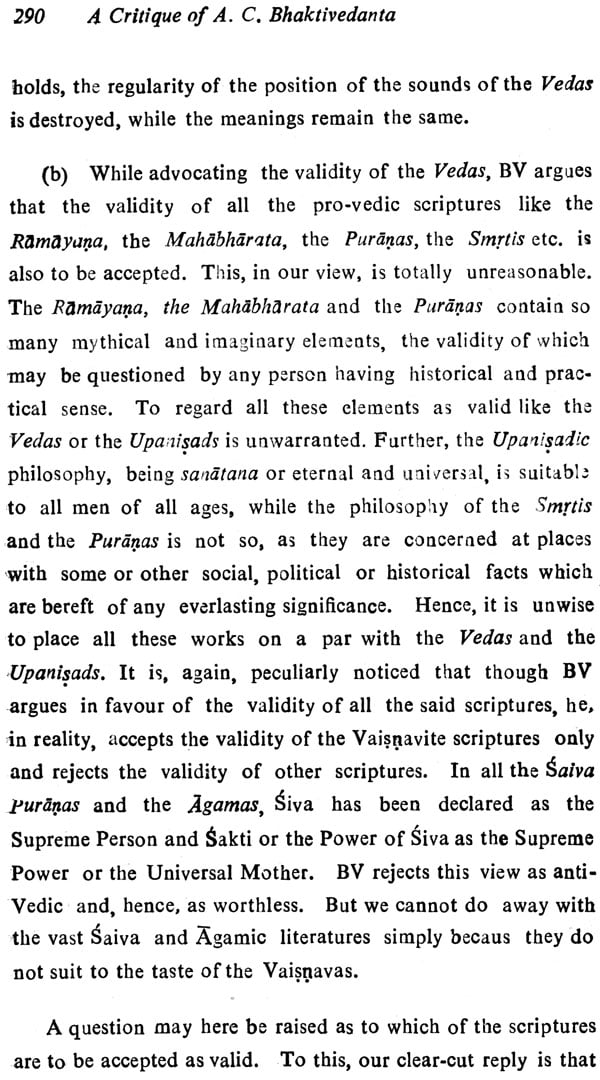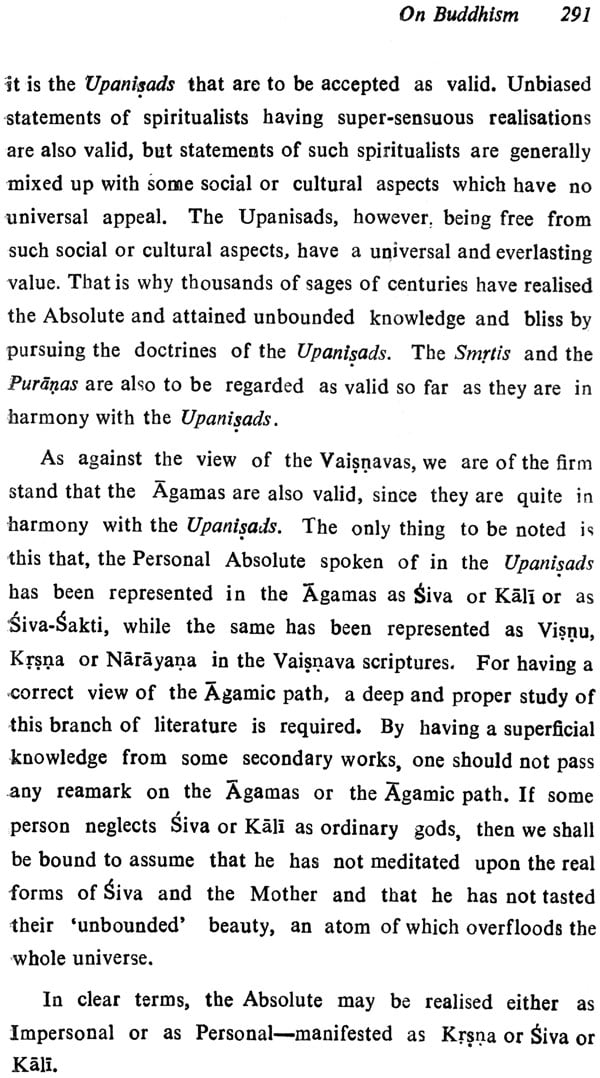
A Critique of A. C. Bhaktivedanta (A Old Book)
Book Specification
| Item Code: | NAG108 |
| Author: | K. P. Sinha |
| Publisher: | PUNTHI PUSTAK |
| Language: | English |
| Edition: | 1997 |
| ISBN: | 8186791094 |
| Pages: | 313 |
| Cover: | Hardcover |
| Other Details | 8.5 inch X 5.5 inch |
| Weight | 340 gm |
Book Description
In the present work, Prof. K. P. Sinha has made an attempt to refute almost all the objections raised by A.C. Bhaktivedanta, the founder of ISKCON, in his works – Sri Caitnya-Caritamrta, Srimad Bhagavad-Gita and others-against the non-Vaisnavite religious systems of India, particularly, against Advaita Vedanta. In the view of the present author, most of the objections raised by Bhaktivedanta are based on misinterpretations of the concepts of the systems taken for criticism. He has, therefore, ventured, in the present work, to point out those misinterpretations and to show the correct views of the relevant concepts of the systems concerned. He has, however, got nothing to say against Bhaktivedanta’s views or interpretations of his own religion i.e. Sri Caitanya’s Vaisnavism.
Dr. K. P. Sinha passed M.A. in Sanskrit from Jadavpur University in 1963. He obtained the Ph. D. degree from the same University in 1968 and the D. Litt. Degree from Burdwan University in 1982. Dr. Sinha is a devoted researcher in different fields of Indian philosophy. Besides, he is the first exponest of the Bishnupriya Manipuri linguistics.
Sri Caitanya’s religion marks the finest development of the cult of Vaisnavism or indeed, of the path of devotion in India. And it is a matter of great joy that A. C. Bhaktivedanta, founder of the International Society of Krisna Consciousness, has taken this religion to every corner of the world and has practically established it as a world religion. This inspired me to study the works of Bhaktivedanta with keen interest and with deep reverence for him. But while going through his works, I had to stumble at every step on his misinterpretations of other systems and on his unkind remarks against them. Such misinterpretations and unkind remarks are really painful, since they tend to implant an uncatholic outlook in the hearts of the readers and to give rise to ill-feelings unnecessarily against other religious system.
We have, therefore, ventured to undertake the task of pointing out those misinterpretations and giving the correct viewa of the relevant concepts of the systems concerned, in the hope that my efforts may be able to remove, to some extent, the evil effects these misinterpretations and unkind remarks tend to create in the hearts of the readers of Bhaktivedanta’s discourses. We are of the view that misinterpretations of other systems are uncalled for, since the acceptance of the real views of the system concerned will not, in any way, affect the worth of Sri Caitanya’s philosophy. The only thing required for synthesis-ting the views of different religions is to accept the well-known maxim that ‘men follow different paths of religion because of the difference in their ‘ruci’ or taste’ and also the great saying of Sri Ramakrishna that ‘all the systems are but different paths leading to the same goal-the Lord’.
In our present discourses, we are going to criticise only those views or remarks of Bhaktivedanta which, in our view, are based on misinterpretations of other systems and are marks of his disregard for them. We would not criticise his views on Sri Caitanya’s philosophy itself, for it must be admitted that there is little to say against them.
We are thankful to Sri Sankar Bhattacharya of Punthi Pustak who has taken interest in this work and published it within a short time.
Religious tolerance is one of the greatest messages of Indian culture. From the earliest times till today, Indian sages have been propagating the great sermon that all religions lead men to the same goal-the Lord or the Highest Reality. By ‘religion’, of course, we mean ‘paths that are prescribed for the realization of the self or the Absolute Reality’, and not those that have nothing to do with such realization. Accordingly, the aforesaid view of the different paths of religion is not applicable to those systems which, in the name of religion, are confined only to some observances of external rites and ceremonies and are not concerned with the knowledge of the self or the Absolute. Except a few so-called religions of this sort, all religions endeavouring to lead men towards the knowledge of the self or the Absolute have been averred by the enlightened sages to be real paths taking men to that ultimate goal of life.
From very ancient times, Indian sages have certified four principal paths as capable of arousing in men the knowledge of the self or the Absolute. These four paths are : (1) jnana or knowledge based mainly on mental speculation and meditation, (2) yoga based on mental and physical practices, (3) karman or action performed without an eye to the fruits, and (4) bhakti or devotion. The ideal set forth in the path of jnana is the realization of identity between the self and Brahman, that in the path of yoga is the realization of the real nature of the self, that in the path of karman is the attainment of tranquility of the mind in all actions and that in the path of bhakti is the attainment of the Lord in some personal form and maintenance of a sweet relation with Him.
It has been declared by the sages hundreds of times that the summum bonum of human life can be attained by pursuing any of these paths. The Upanisads, the Brahma-sutra of Badarayana, the Bhagavata-Purana, the Mahabharata, the Bhagavad-Gita, the Pancaratra works and all other fundamental treatises on religion without any exception hold the same view in this regard.
On the philosophical problem whether the Absolute or Brahman is saguna i. e. endowed with qualities or nirguna i.e. devoid of qualities, all the above-mentioned scriptures and treatises are consistent in holding that Brahman is both saguna and nirguna. And on the problem whether Brahman is sakara i.e. endowed with form or nirakara i. e. devoid of form, these source-books consistently say that Brahman is both sakara and nirakara’. Again, on the problem whether the self is identical with Brahman or is different from it, these treatises uniformly subscribe to the views of both abheda or identity and bheda or difference i. e. the self and Brahman are considered both identical with each other and also mutually different. We also find a combination of these two views termed by the later thinkers as a theory of bhedabheda or difference-cum-non-difference.
From the religious point of view, Samkhya, Yoga, Advaita –Vedanta, Vaisnavism, Saivism and Saktism are the well-known traditional systems, and all these systems have been attested by the said scriptures and treatises as paths leading men to the said ultimate goal of life. Even the Tantric path pursued through sex, wine, meat etc. and looked upon by people in general to be dreadful is also acknowledged by the enlightened persons as a means for attaining the Absolute in the form of Siva or the Universal Mother (see Thoughts on Tantra and Vaisnavism by this author).
The question may arise: How can the same Absolute admit of such opposite natures as sakara and nirakara or saguna and nirguna? How can the same Reality be meditated upon as formless Brahman, and also be worshipped as Visnu or Siva or Kali as well? And, again, how can the same Brahman be both identical with the self and yet different from it? In reply, it may be said in short that the Absolute reveals itself to the spiritual aspirants in different forms and natures according to the rucis or tastes (rucinam vaicitryat) of the aspirants. All these issues will be thoroughly discussed in the body of our present discourses.
It has to be noted, however, that when we say that all the religious paths lead the spiritual aspirants to the same goal or to the Lord or the Absolute, we do not mean that the attainments of all the aspirants are the same. For we are aware of that fact that though the same goal or the Absolute is attained by all, the nature of attainment and the bliss accruing from the attainment differ from person to person, because of the difference in the tastes of persons and in the paths pursued. Just as the same person may be enjoyed as friend or father or husband by different persons, so the same Absolute may be enjoyed differently by different aspirants in harmony with their tastes and the paths followed by them. Thus, the Bhagavata- Purana says: “Just as the same object endowed with different qualities is perceived differently by different, organs, so the same Lord can be realized differently by different scriptural paths” (“yathendriyaih prthag-dvarair artho bahu-gunasrayah, eko naneyate tad-vad bhagavan sastravartmabhih”-BP 3.32.33; see Baladeva’s comt. On Laghubhagavatamrta, 206).
Now, though such a catholic attitude to different spiritual paths is displayed in the scriptures, there is a misguided parallel tradition in the religious system of India to misinterpret other systems and undermine their values, For example though the systems of Buddha and Sankara are quite in harmony with the Upanisadic philosophy, they have been interpreted by many to be heretic ones quite opposed to the philosophy of the Upanisads. Hence, in every epoch, the Lord announces-either through His incarnations or through the enlightened persons-the great sermon that all religions lead men but to the same goal, the Lord. In our present epoch, this great truth has been reiterated by the great sage Sri Ramakrishna through his sermon ‘jata mat tata path’ meaning ‘all religious systems are but different paths for attaining the one and the same Lord’. This great sage has proved the truth of this message in his own life through his realization achieved by the pursnance of each and every well-known path of religion.
Accordingly, we think that to undermine other systems by misinterpreting their theories is quite opposed to the tradition of India. Unfortunately, however, such a trend of misinterpreting other systems and undermining them is met with in abundance in the discourses of A.C. Bhaktivedanta, a leading personality in the religious field of the modern world. In the present work, we have, therefore, ventured to point out Bhaktivedanta’s misinterpretations of other systems and to show the correct views of the systems concerned, with a view to wiping out any wrong idea that may arise in the minds of the readers of Bhaktivedanta’s discourses.
To make the readers free from any doubt about Bhakti vedanta’s we whe have, in this work, quoted his words simply as they are and have nowhere restated his views in our own language, Further, to convince the readers about our interpretations and observations, we have extensively quoted relevant passages from the original texts and have given English translations of those passages.
For the convence of treatment, we have divided the view of Bhaktivedanta into a few Sections. In each Section, we have, first, cited a number of passages from the works of Bhaktivedanta and, then, we have given our observations serially on those passages. Where a long discussion is demanded by the context, we have added long Notes at the bottom of the Section concerned.
| Preface | vii | |
| Abbreviations | ix | |
| Introduction | 1-7 | |
| Section 1 : | On the Vaisnavite View of the Absolute as a Qualified Person | 9-45 |
| Section 2 : | On the Vaisnavite View of three Aspects of the Absolute-Brahman, | 47-57 |
| Paramatman and Bhagavat | ||
| Section 3 : | On the Advaita Vedantic Concept of the Formless and Impersonal Brahman | 59-69 |
| Section 4 : | On the Advaita Concept of the Identity between the Self and Brahman | 71-107 |
| Section 5 : | On the Advaita Vedantic View of Devotion | 109-117 |
| Section 6 : | On the Path of Advaita Vedanta or Jnana-marga (The Path of Knowledge) | 119-141 |
| Section 7 : | On the Paths of Bhakti (Devotion) Yoga and Jnana (Knowledge) | 143-155 |
| Section 8 : | On the Followers of Sankara and some of their Views | 157-169 |
| Section 9 : | On the Advaita Vedantic Concept of the Individual Self and the Material World | 171-192 |
| Section 10 : | On the Theories of Vivarta or Appearance and Parinama or Transformation | 193-201 |
| Section 11 : | On Sankara's Views about the Vyuhavada | 203-209 |
| Section 12 : | On the Question of Sri Krsna's Material Body | 211-221 |
| Section 13 : | On the Concept of Mahavakya | 223-227 |
| Section 14 : | On Samkhya, Yoga, Mimansa and Carvakism | 229-244 |
| Section 15 : | On the Concepts of the Gods-Siva, Durga, Kali and Others | 245-253 |
| Section 16 : | On Buddhism | 255-291 |
| Bibliography | 295-297 | |
| Index | 301-304 |
